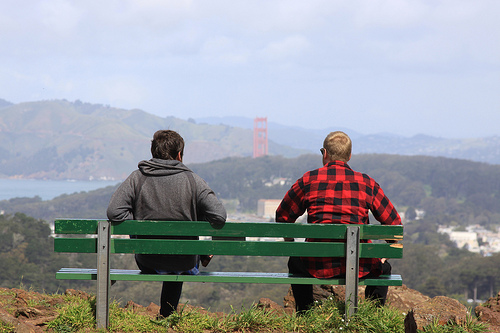 |
| Source: http://www.theatlanticcities.com/housing/2011/11/geography-stuck/534/ |
And more importantly, why is Atlantic Cities, an otherwise admirable project to provide an outlet for contemporary American urban thought and criticism, still publishing it?
Admittedly, Florida was able to discern and accurately describe an important trend- that what he coined the "Creative Class" (or the young, tech-savvy, mobile and creative demographic) is an important economic driver in some places, and that by considering the needs and desires of this subgroup, a legitimate approach to economic development, one beyond chasing large companies with tax abatements, might be found.
But.
He has long since gone too far, writing off broad swaths of the country as economic losers incapable of ever attracting the mobile, creative types which are, in his view, the sole path to future prosperity. A 2009 American Prospect article, "The Ruse of the Creative Class" deftly shines a bright light on the many holes, contradictions and shortcomings of his arguments:
A tautology lies at the heart of Florida's theory that has limited its instructive value all along: Creative people seek out places that draw a lot of creative people. Florida has now taken this closed-loop argument to another level by declaring that henceforth, the winners' club is closed to new entrants.By pegging the economic hope of the future on a single narrowly defined demographic subgroup, he has discounted not only most places, but most people.
And now, in a breathtakingly overly simplistic analysis of state-level census data showing the percent born in their state of residence, Florida has created a new American dichotomy- the "mobile" vs. the "stuck" to serve as evidence for his views:
America can be divided into two distinct classes, the stuck and the mobile. The mobile possess the resources and the inclination to seek out and move to locations where they pursue economic opportunity. Too many Americans are stuck in places with limited resources and opportunities. This geography of the stuck and mobile is a key axis of cleavage in the United States.Let's not even begin to attempt to define the meaning of "axis of cleavage."
It's hard to know what conclusions to draw from this map. Florida reads it this way: states with high percentages of native-born residents (primarily the midwest) are centers of the talentless and uncreative: the "stuck." Those with low percentages (the coasts and the Rocky Mountain states) are magnets for the creative, talented "mobile."
Maybe.
But the coasts have long been the first point of immigration from other countries and the destination of recent college grads- many of whom eventually end up settling in or returning to the more affordable midwest. Not a new story.
And yes, clearly the midwest has lost population with the decline of manufacturing.
But does that mean all or most of it's remaining residents are "stuck?"
What about those who choose to stay in or return to their native-born state, who weigh the tradeoff between a higher cost of living far from family, and an affordable one with friends and family nearby, and decide that staying put makes sense? Do they lack talent and drive? Are they "stuck?"
What about those who are invested in a place, who have deep roots and care about their community, who know who they are and where they come from? What about those with economic connections- a family business- or emotional connections- a family history? Do they lack some creative gene, dooming them to economic and cultural doldrums?
I wonder about the long-term sustainability of places like San Diego, Seattle, Boston and Portland, places well-known for catering to particular demographic characteristics and lifestyle preferences.
I wonder about places where no one has parents.
I wonder about a "class" of people defined primarily by their mobility; their willingness to surrender their roots, to move from place to place in pursuit of the next big thing.
Scott Russell Sanders in Staying Put: Making A Home in a Restless World writes:
For me, the effort of being grounded in family and community is inseparable from the effort of being grounded in place.On the flip side of mobility, maybe there is economic value in a willingness and ability to settle down and be grounded in a particular place, and to commit to making that place better.
Maybe we need both "classes" to build an economic future that is both dynamic and stable.
And perhaps we can coin a better dichotomy.
Maybe they are not the "stuck."
Maybe they are the rooted.







